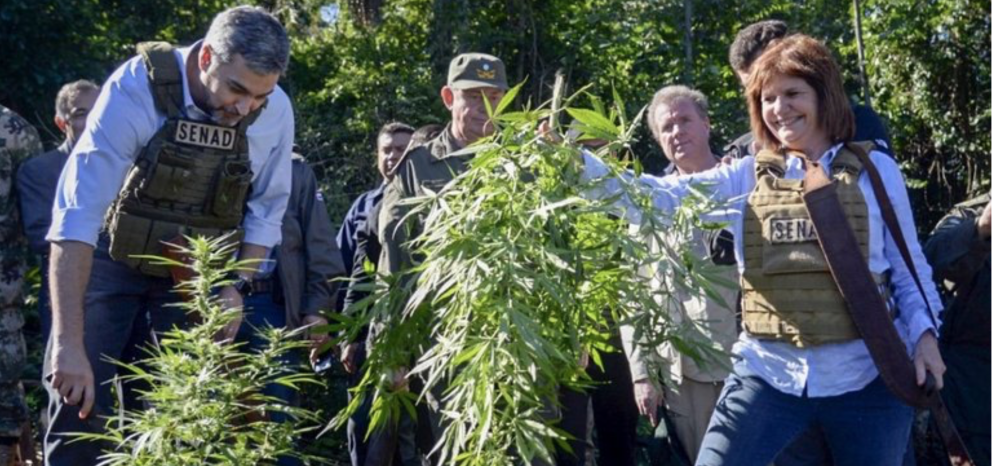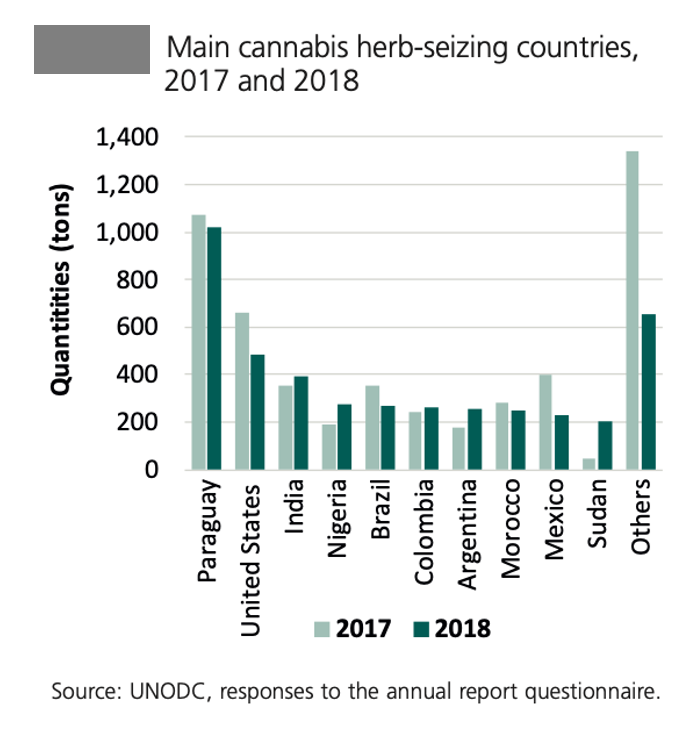Most of the cultivation takes place in the area around Pedro Juan Caballero, near the Brazilian border, which is the country's criminal center.
° Marijuana plantations cover some 8,000 hectares, with a production of 30,000 tons, 77% of which goes to Brazil and 20% to Argentina.
As a transit point for cocaine from Peru and Bolivia, Paraguay has made a leap in the Issue of shipments to Europe: at the beginning of 2021, there was a record shipment of 23 tons.
° The Paraguayan congress has C medical use of marijuana; for the moment it is not following in the footsteps of Mexico, the leading producer in the Americas, which is discussion its full legalization.

► Paraguayan President Mario Abdo Benítez and the then Argentine Minister of Security, eradicating marijuana plants in PJC [Gov. of Paraguay].
report SRA 2021 / Eduardo Uranga [ PDF version].
MAY 2021-Paraguay is on the rise on the drug trafficking map, as the largest producer of marijuana in South America and a distributor of cocaine from Peru and Bolivia. With an estimated cannabis cultivation area of almost 8,000 hectares and an annual production that can approach 30,000 tons, Paraguay exports this drug to Brazil and Argentina. The cocaine that passes through the country is destined for these two large neighbors and especially for Europe: in February 2021, German authorities intercepted a shipment of 16 tons of cocaine, the largest ever shipped from Paraguay, a finding that rose to 23 tons counting a shipment located two days earlier in Antwerp. Another 11 tons were found in the same port in early April.
Although, in the case of Paraguay, the most surprising development in the last year has been this leap in the capacity to generate large cocaine shipments, the rapid evolution of the international context in relation to marijuana - for example, the UN reclassified it in December 2020, noting its therapeutic potential - makes this other lucrative illicit trade particularly topical.
The growing legalization of the hemp leaf that is beginning to take place in some countries, generating its own productions (unlike coca, which due to its specific conditions is cultivated almost only in Colombia, Peru and Bolivia, marijuana can be grown in different places, also in greenhouses) offers business perspectives to the farmers who today in Paraguay deal with its illegal cultivation, The Paraguayan mafia structure, which is of Brazilian origin, is not so much interested in marijuana as in Uruguay, the only nearby country that has legalized national production for open use, because Paraguayan marijuana would have to be sold more cheaply than Uruguayan marijuana in order to compete in Uruguay, the only nearby country that has legalized national production for open use. Mexico, which is the largest producer in the Americas, is in the process of decriminalizing its recreational use; Paraguay is not there yet, but the law approved in August 2020 to allow medicinal use, admits individual cultivation if there is a medical certificate .
Production and eradication
Marijuana production is linked to organized crime, which operates especially in the border areas with Brazil. According to figures provided by the National Anti-Drugadministrative office (SENAD), the largest operations against the cultivation of this drug take place in the department Amambay, whose capital, Juan Pedro Caballero, is the country's criminal center. That city is adjacent to the Brazilian border and shares an urban mass with the Brazilian town of Punta Porá. The adjacent department of Canindeyú, also bordering Brazil, is also home to extensive plantations.
In the decade 2009-2019, SENAD destroyed 9,838 hectares of marijuana plant cultivation in Amambay and 2,432 in Canindeyú, together representing around 90% of the 15,045 hectares eradicated nationwide. In 2019, the latest damage referenced by SENAD, authorities eradicated 1,468.5 hectares, the highest figure of the decade, which not only indicates an increase in the anti-narcotics effort, but also suggests an increase in the extensions cultivated.
Paraguay is estimated to have between 6,000 and 8,000 hectares with marijuana plants. An improved seed introduced a few years ago has made it possible to expand the usual two annual harvests to three or even four harvests, raising productivity to between two and three tons of marijuana herb per hectare, bringing total production to as much as 20,000 tons per year. These figures may have been underestimated, as SENAD has estimated that up to 30,000 tons of weed could have left the country in the last year.
The United Nations Office on Drugs and Crime (UNODC) World Drug Report 2020 places Paraguay as the country with the largest marijuana seizures, at over 1,000 tons per year. The report also indicates that hemp resin production is minimal (1.1 tons in 2016) and that 77% of the marijuana generated in Paraguay is destined for the Brazilian market and 20% for the Argentine market.

In the Americas, Paraguay's production is second only to Mexico, which has an estimated 12,000 hectares of plantations, agreement to the US government's 2021 International Narcotics Control Strategy Report (INCSR). The cultivated area eradicated by Mexican authorities is also greater, although that effort has fallen in recent years (5,478 hectares in 2016, 4,193 in 2017 and 2,263 in 2018), as indicated by the UNODC report , which at the same time notes that some 200 tons of marijuana were seized in Mexico in 2018, compared to 400 in 2017.
Corruption
Paraguay is a fertile ground for the establishment of criminal networks. Its strategic position is a determining factor and a fundamental condition for organized crime to choose Paraguay as a hub for its criminal activities. Located between the Peru-Bolivia coca production centers and the growing markets of Argentina and especially Brazil, which are also the destination of Paraguayan marijuana, the country is a place of operations for mafias, especially Brazilian. The conditions of the Triple Border - the conurbation formed by Ciudad del Este (Paraguay), Foz de Iguaçú (Brazil) and Puerto Iguazú (Argentina) - also encourage smuggling, product counterfeiting and money laundering, as well as the financing of terrorist groups(such is the case of Hezbollah).
Economic factors also play a role. Economic and social marginalization is an element that these organized crime gangs use to recruit "employees. However, this factor can only partly explain the particular development of these networks. Its dimension depends fundamentally on the level of acceptance and tolerance of corruption. Paraguay has, in this sense, the ideal conditions for the development these networks. This is due to its high levels of state corruption, as indicated in the Corruption Perceptions Index.
Underscoring the obstacle that corruption in Paraguay poses to the fight against drug trafficking, in January 2020 there was a mass escape from a prison in Pedro Juan Caballero of 75 inmates, mostly members of a Brazilian criminal gang known as the First Capital Command (CCP). The escape was facilitated by the collusion of officials and highlighted the impunity with which many of the drug traffickers operate.